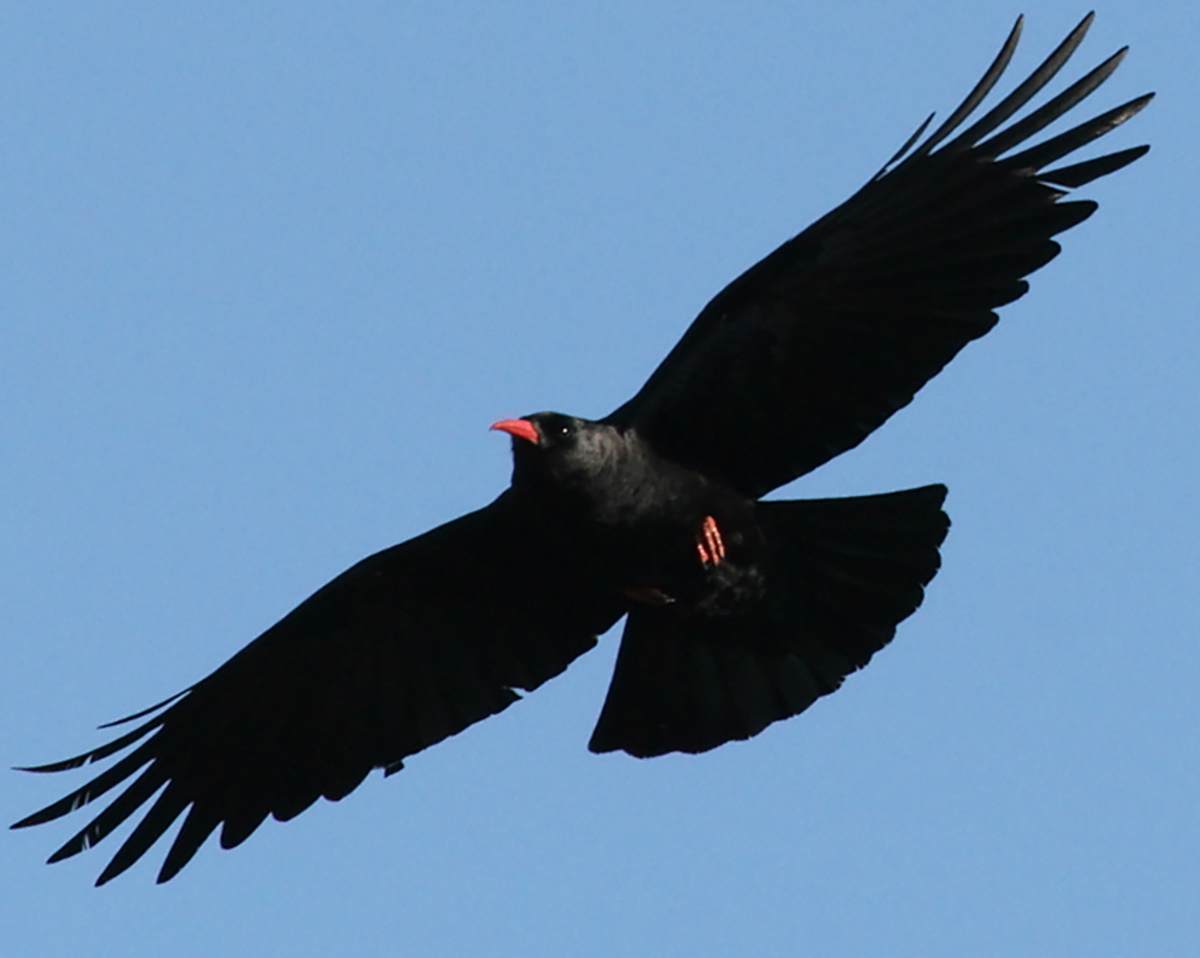March 2010 – Wardens Greg and Lisa
A cold month on Ramsey Island following on from a very cold winter has affected some species. Chough were a bit late to get going, more interested in feeding up after a tough few winter months than getting round to breeding. First nest building was on 22/3. By the end of the month 5 pairs had been confirmed with another 3 on territory and we hope they will start nest building soon.
Lapwing had an equally tough winter and although it is too early for us to establish final breeding numbers yet, a max of 6 birds displaying is down on recent years at this stage. Another species seemingly hit by the weather is stonechat. They disappeared from the island after Christmas and only a very few have returned so far.
Wheatears however, which spend the winter in Africa, have returned in apparently good numbers. In 2009 we had 115 pairs nesting on Ramsey (over 25% of the Pembrokeshire population) and the first migrants returned on 7/3 this year. Male birds are the first to be seen as they head back in advance of the females to reclaim their territories. Other regular breeders setting up territory are peregrine falcon (2 pairs), buzzard (2 pairs) and raven (4 pairs). Skylarks and meadow pipits have been singing for most of the month, a sure sign that spring is round the corner……
Returning migrant dates include chiffchaff (25/3) and sand martin (19/3). Two merlins (a male and a female) were seen on and off during March. A red kite on 25/3 was a relatively rare sight out here. Our cliff nesting auks (guillemots and razorbills) have been on and off the ledges throughout March. They will keep up this sporadic attendance until they lay their eggs in late April / early May.
Moulting grey seals can be readily seen around the island at this time of year. Up to 150 have been hauled out on the main beaches during March and good numbers should continue through April. Anyone approaching by boat should do so with care as they are very jumpy at this time of year and moulting is a very important process for them; the quality of their new coat affecting their health for the remainder of the year. An out of season seal pup was born in early March. It has done very well and is on the verge of weaning.
April 2010 – Wardens Greg and Lisa
7 pairs of chough confirmed as breeding. An 8th pair was settling down when a 3rd bird intervened and put everyone off! Only 2 pairs of lapwing made it back this year unfortunately, presumably not helped by the cold winter. There are 3 peregrine territories this and a pair of kestrel. 4 pairs of raven are on the verge of fledging young while the whitethroats are only just arriving back.
Highlights included hoopoe (2+3/4), a female yellowhammer on 10/4 (4th record since RSPB records began), snow bunting (21/4 to end month), 5 ring ouzels through April, Cetti’s warbler (25/4), bullfinch (16/4), black redstart (7/4), 4 common redstarts in April, barn owl (16/4), grasshopper warbler (23+30/4), green sandpiper (12/4), hooded crow (21/4), jack snipe (24/4), white wagtail (14/4), redpoll (15/4), hobby (24/4), yellow wagtail (21/4), 5 red kites in the period plus a female/juv merlin through March and April, joined by a male at times.
First returning dates: wheatear (7/3) plus Greenland race on 3 dates in April, sand martin (19/3), chiffchaff (25/3) swallow and house martin (3/4), blackcap (4/4), willow warbler (7/4), whitethroat (18/4) and swift (22/4).
An otter was seen on the west coast of the island by boat staff on 17/4 and a fresh spraint was found on the harbour steps on 22/4. Grey seal haul outs peaked at 150+.
May 2010 – Wardens Greg and Lisa
Feels like March……….. After the glorious weather of April on Ramsey Island things have taken a step back! A cold northerly airstream has established itself over the UK and the temperatures have taken a real knock. North or north east is the worst direction for boats as our harbour faces in that direction so we have lost a few days of landings as a result.
The number of migrant birds has dried up as a result of the wind direction but the residents are well into thier breeding cycle. Choughs are still incubating and the earliest nest builders should have chicks to feed any day now. We saw the first guillemot egg on May 4th and kittiwakes were busy nest building yesterday. They are a bit like the house martins of the seabird world and cement an intricate nest of wet mud and grass to the cliff face.
We have 9 ewes left in the lambing fields (although not all are pregnant) and just when we thought the fun and games were over Lisa and I had to pull a lamb yesterday that was stuck with one leg out and one back. I am pleased to say that both ewe and lamb are doing well this morning.
June 2010 on Ramsey Island
We had a brilliant half term week, with fine and sunny weather and over 80 visitors on many days. It was great to meet so many enthusiastic and friendly people; we filled two guided walks and manned a seabird watch point on our 100 metre high cliffs, allowing visitors to get close up views of breeding Guillemots and Razorbills through a telescope. Our excellent volunteers were on hand to give information and helped people get the most out of their visit.
These birds were just beginning to hatch their single eggs at the end of last week and are now busy ferrying back and for form the island with silver sandeels for their small but hungry chicks. Several puffin sightings again last week, all very close to the island’s west coast. Boat skippers from many of the local wildlife boat trip operators are regularly reporting their sighting by text and VHF radio and we are very grateful to them for their help. The skipper of the island boat, Gower Ranger, was so keen that we have provided him with his very own ‘Wildlife Sightings’ notebook that he keeps in the cabin in order to record his sightings during the day.
Chough are still feeding chicks in their nests, with some broods niosy enough to hear them from the cliff tops. First fledgling birds seen out and about this week, with young wheatears, stonechats, skylarks and blackbirds all in evidence. Our first Red deer fawn of 2010 was also born last week. It’s mother is keeping it well hidden in the centre of the island, where she has access to fresh water, but patient visitors, sitting at the top of Carn Llundain were rewarded with views of the little newborn, down below them.
Our orphaned lambs are now all at 50 days of age or more and have all been weaned off the bottle. It is quite a shock for them as the best way to encourage them to graze is to drop from 1.5litres of milk one day to zero the next. So it’s pretty sudden, but it really is the best way to maintain there growth rate. They are now happy in a large field of lash grass with our rams and will hopefully de-humanise over the next couple of weeks, perhaps they will soon remember that they are sheep and not human after all. Shearing is the next big job as far as the sheep flock are concerned, due in the next week or so.
July 2010 RSPB Wardens on Grassholm Island
Over the last two weeks we have been busy working out on Grassholm Island, which lies 7 miles southwest of Ramsey Island. You might just have heard of this amazing, 9-hectare, piece of low-lying rock in the middle of the Irish sea. It is the oldest RSPB reserve in Wales and is home to nearly 10% of the world population of northern gannets. In fact at the last count, (don’t ask how we did it), we had 39, 292 pairs breeding on the island.
Greg and I have been working with the amazing seabird biologists from University of Plymouth to find out what our Grassholm gannets get up to when they are away from the island.
One exciting piece of work that is currently underway looks at non-breeding gannets. They do not have a nest site but do visit the colony in large numbers to visit ‘club sites’, a little like a youth club for teenage gannets. These sub-adults can be anything from 2 years to 4 years old. As they are not yet constrained to any one colony, they are able to range over wide areas of ocean, visiting other gannetries and potentially putting themselves in contact with a wide range of threats.
By attaching a small satellite transmitter to12 birds, we are able to follow their every move, in real time, live on-line. To find out where our birds are heading, just go to:
www.seaturtle.org/tracking/?project_id=497
In the nine days since we deployed these devices, one of our birds has covered over 1,300km, it left Grassholm on 5 July, headed south around the tip of Cornwall and then travelled east along the English Channel. It is currently heading up into the North Sea. Will it really go anticlockwise right round the coast of the UK to get back to Grassholm?
It is vitally important that we find out more about the.
August 2010 – RSPB Wardens Greg and Lisa
A brief bird and seal report for the season on Ramsey Island so far.
With the breeding season approaching an end (for birds if not seals!) here is a breakdown of some of the highs and lows:
Chough – fledged 17 young from 7 nests (2.42 per pair, joint 3rd highest productivity on record).
Lapwing – 2 pairs managed to fledge 1 young between them (not a bad effort!).
Wheatear – 106 pairs – surely the densest site in Wales for this species?!
Stonechat – down from 25 pairs in 2009 to 6 pairs this year. No doubt a casualty of the cold winter. In fact we noticed that all small passerine species that are resident in the UK and breed on Ramsey (e.g. Meadow and rock pipit, blackbird, dunnock) were also slightly down this year too.
Seabirds – a good year generally. No sign of food shortage although kittiwakes were down from 225 pairs in 2009 to 191 pairs (following 3 years of increase) and how low productivity at the study site (0.26 per pair, although the Cantwr site at the southern end seemed to do much better based on very helpful reports from boat operators).
A full storm petrel survey on the Bishops and Clerks revealed 149 occupied sites (the highest estimate for this site). The few, newly discovered, birds on Ramsey continue to do well with all 5 from 2008 relocated and a new site found too.
Kestrel – 1 pair fledged 4 young. Good news for a species that is in decline in Wales (red kites now outnumber them!).
Peregrine – 2 pairs although no young seen to fledge.
Grey seals – going well with well over 100 seal pups born so far on our 9 monitored sites so far.
Guided Walk on Ramsey Island with wildlife guide Lyndon Lomax
This weeks guided walk on Ramsey Island was lead by local birder Lyndon Lomax, besides the lovely secenery here are some of the sightings spotted by the group:
2 x Peregrine Falcon . 8 x Chough . Ravens . Buzzards . Kestrels
Lots of Atlantic Grey Seals and their pups
6+ Porpoise in Ramsey Sound
1 x Bottle Nose Dolphin in Ramsey Sound

